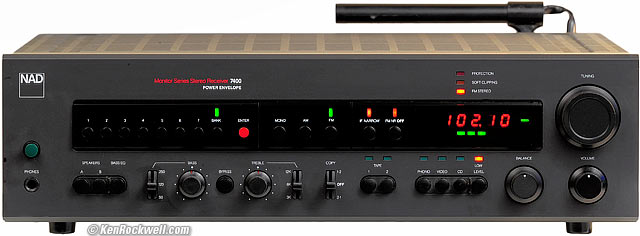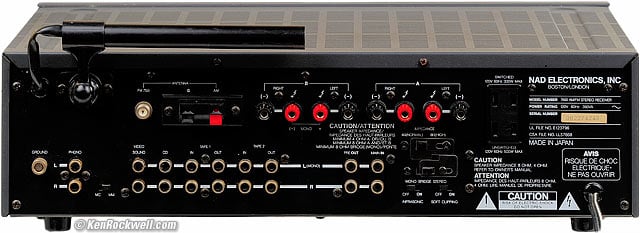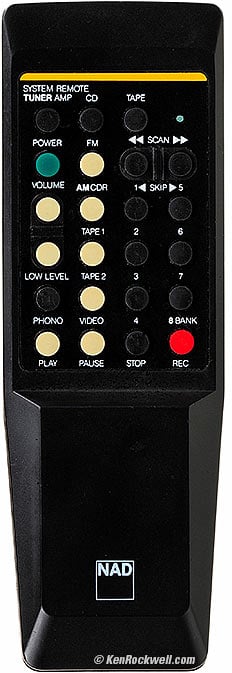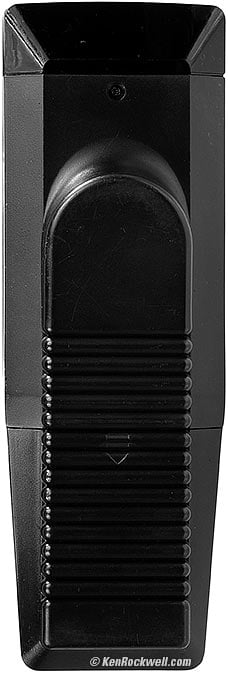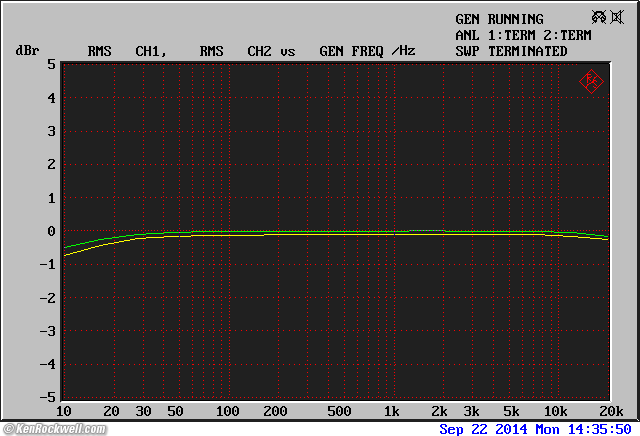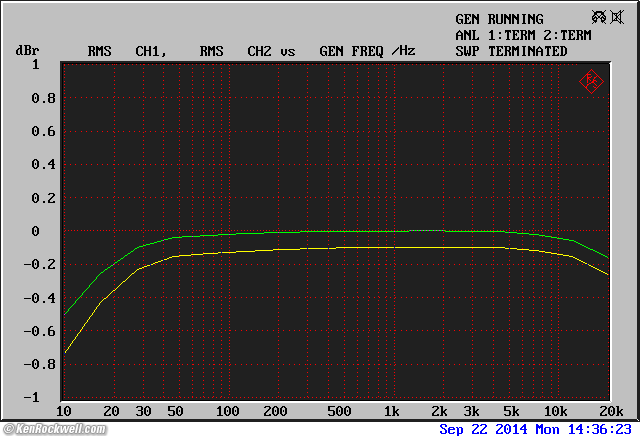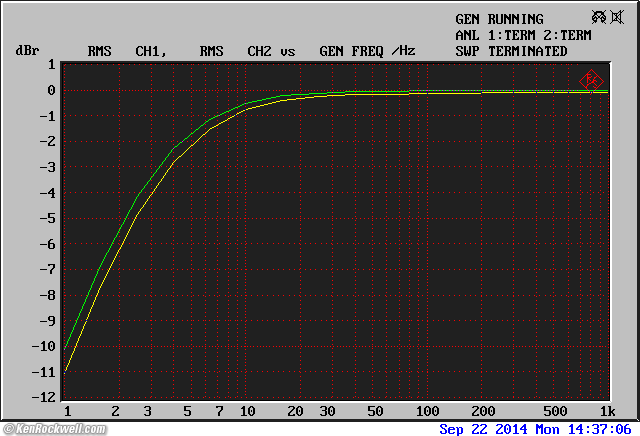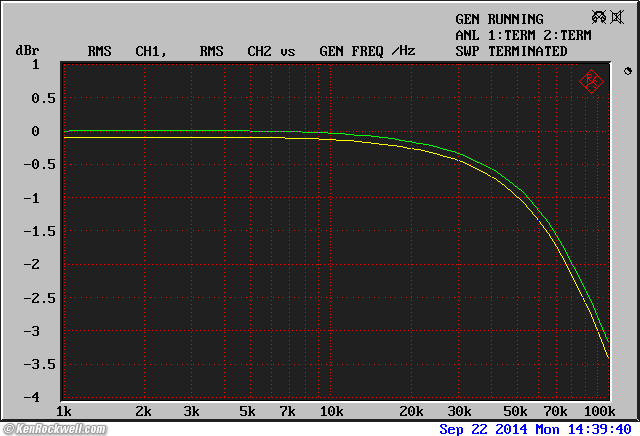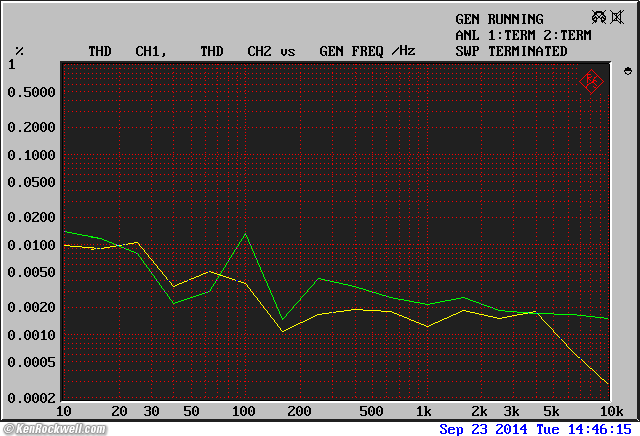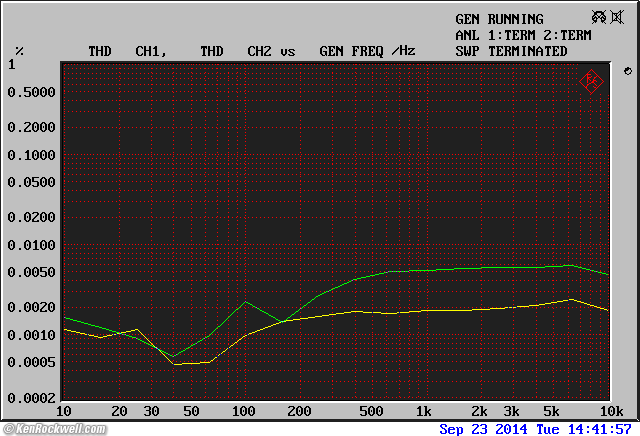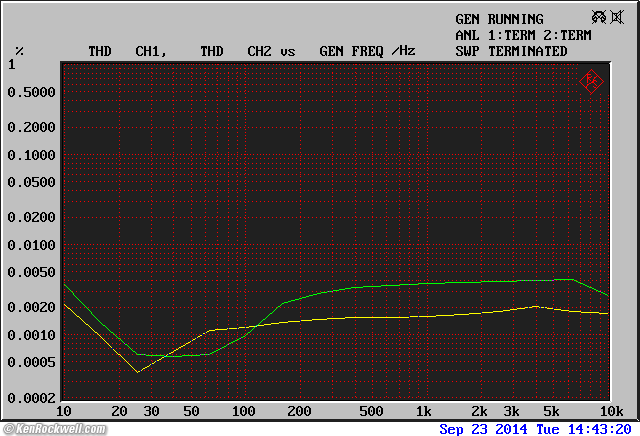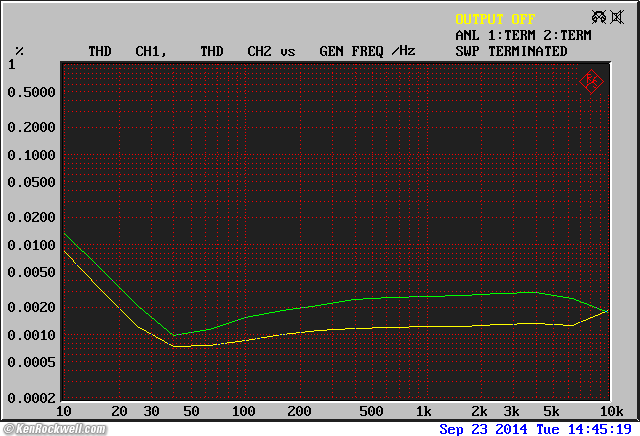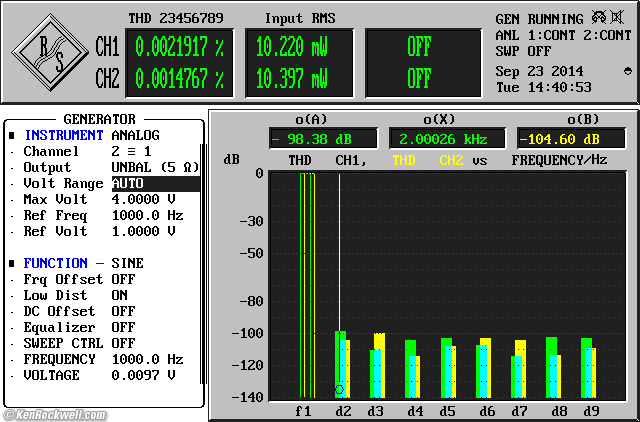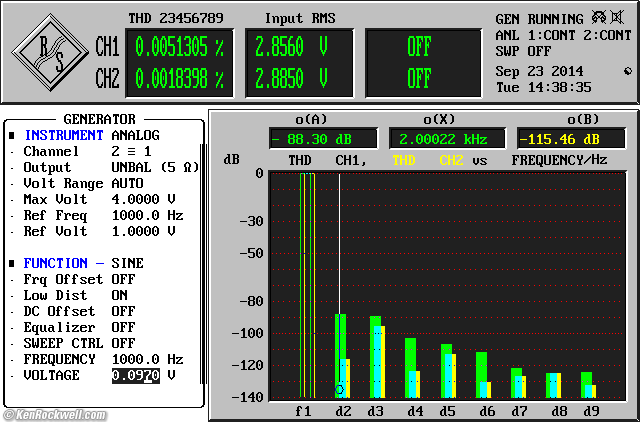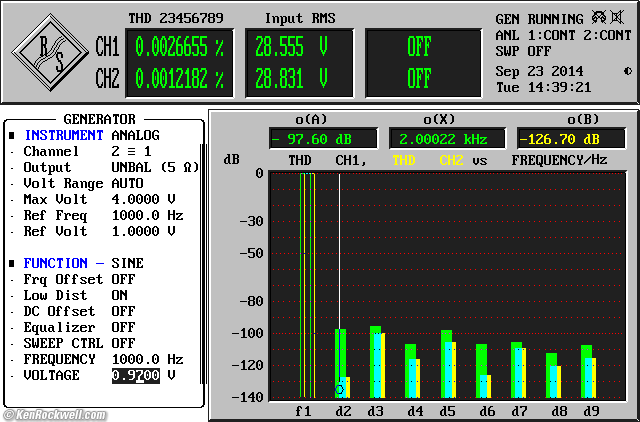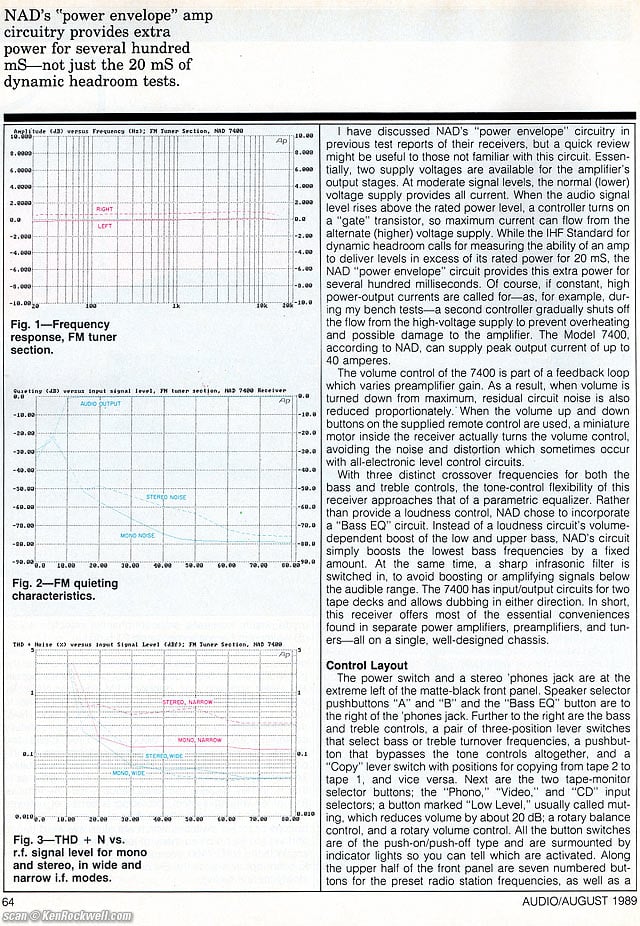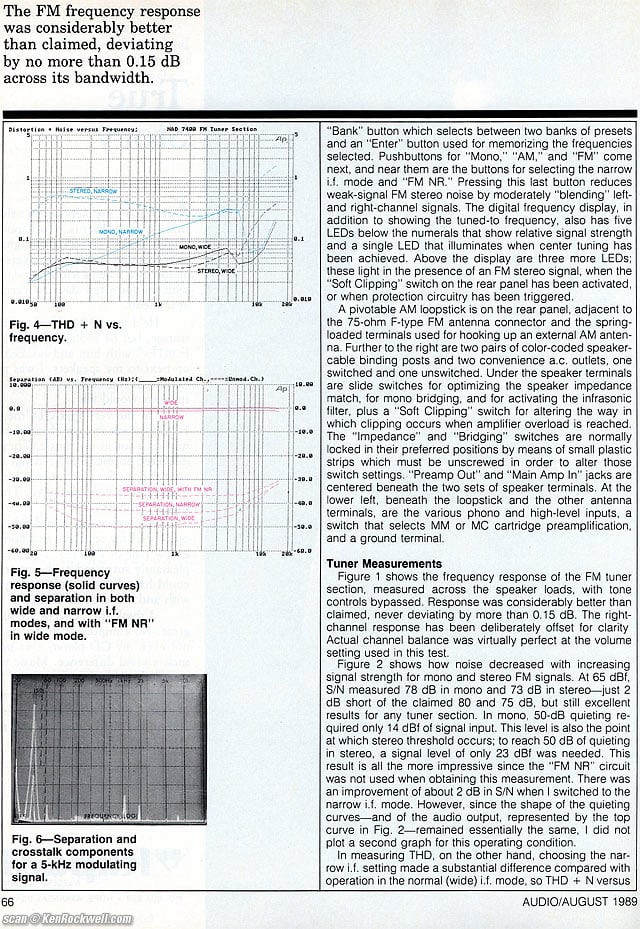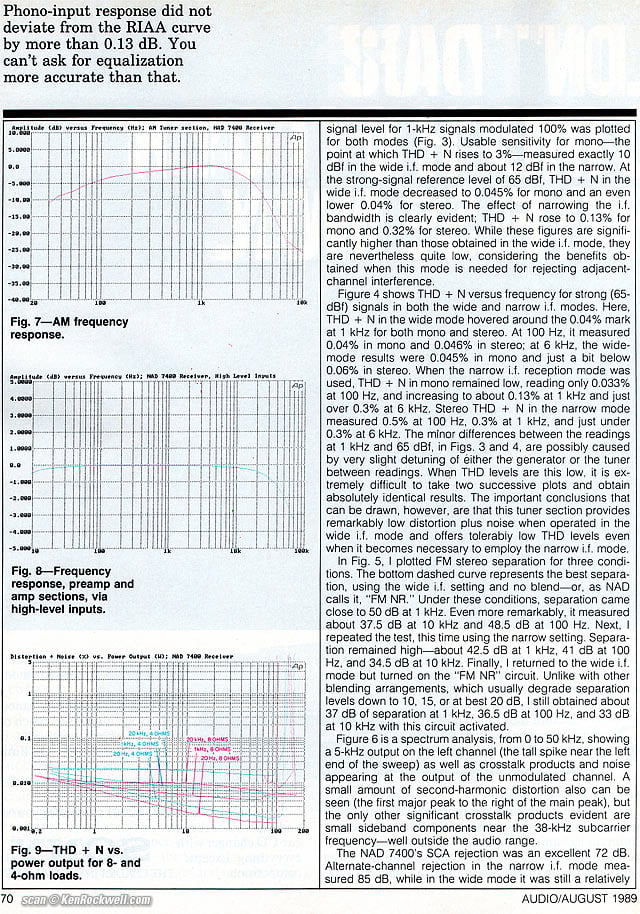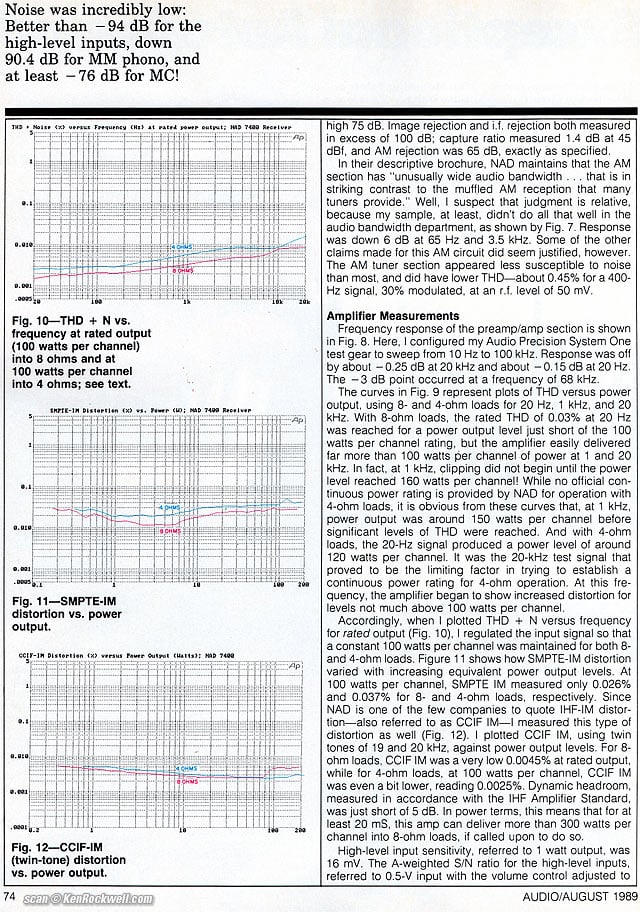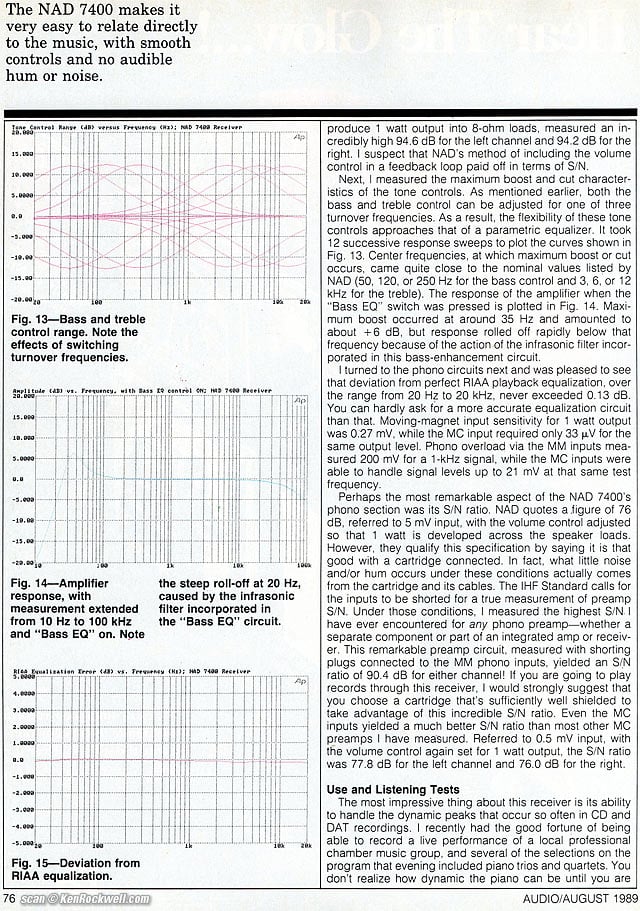Home Donate New Search Gallery Reviews How-To Books Links Workshops About Contact
NAD 7400
Monitor Series AM/FM Stereo Receiver (1988-1991)
© KenRockwell.com. All rights reserved.
Intro Specifications Measurements Compared
NAD 7400 (rated 100 watts per channel into 8Ω, 350 W actual measured clean burst power, 26.0 lbs./11.8 kg, measured 60 watts idle power draw, about $250 used). enlarge. I got this mine at this link directly to them at eBay (see How to Win at eBay).
This free website's biggest source of support is when you use those or any of these links to approved sources when you get anything, regardless of the country in which you live — but I receive nothing for my efforts if you take the chance of buying elsewhere. I get no government hand-outs and run no pledge drives to support my research, so please always use any of these links to approved sources for the best prices, service and selection whenever you get anything. Thanks for helping me help you! Ken.
Rear, NAD 7400. enlarge.
October 2014 NAD reviews audio reviews all reviews
Introduction top
Intro Specifications Measurements Compared
The NAD 7400 is a great-looking receiver that works as well as it looks. The reason I bought one used in 2014 is because it's big, well designed buttons and knobs make it fast and easy to get to my music, compared to the garbage sold new today that requires menus and fiddling to get anything adjusted. Every big button is clearly marked and does only one thing.
One of the best things about this receiver, other than how it looks and sounds, it its tuning knob. It's the best of all worlds: it's a free-spinning flywheel knob that is opticoupled to a digitally synthesized tuner. This way it tunes and scans like a slide-rule-dial tuner (ten times faster than arguing with push buttons), and it has quartz-synthesized frequency accuracy. Older tuners lacked the tuning accuracy and precision, and newer ones got cheap with crummy UP - DOWN push buttons instead of the big flywheel knob.
Likewise specific to NAD, earlier receivers tended to have crummy push terminals for the speakers (this 7400 has real banana post pairs), and newer NADs got rid of the clear, direct controls.
These NADs were originally relatively inexpensive receivers that used clever design and off-shore manufacturing to extract great sound out of an inexpensive package.
It has a metal face and push-on plastic knobs. No set screws here!
The remote control is much more legible than others, and it's designed so that the infrared LEDs shine out the bottom as well as the front, so you can point the bottom or the front at the receiver as you read the buttons.
NAD Monitor System remote control. enlarge.
There are LEDs on the remote control to let you know it's transmitting, and another LED on the front face of the NAD 7400 to let you know it's receiving. Brilliant!
The green power button is a long-push button that tells the computer to turn the power on or off. It's not a bigger switch actually handling the power itself as in older equipment.
The FM tuner has an IF NARROW position to increase selectivity to allow receiving weak stations that are normally covered by stronger local stations.
The FM tuner tunes in 50 kHz steps so you can detune to pick up a very weak station next to a very strong station. Stations in the USA are spaced 200 kHz apart.
The 5-LED signal strength meter works great on both FM and AM. It will read lower than useless meters that usually read full-scale all the time. When it reads 3 out of 5, you've got a good signal. 4 is very good, and 5 is excellent. 2 is OK, 1 is getting weak, and none is weak.
There are no overload lights for the power amplifier. NAD has all sorts of crazy soft clipping.
There are loads of lights on the front panel when playing the radio, but only one or two LEDs lit when playing other inputs. All the tuner lights extinguish if you're not listening to it.
All the push buttons have a relatively long throw. The speaker and BASS EQ buttons toggle in and out, while the others pop out after being pressed.
Circuit Design
As I understand it, it uses a class AB power amplifier, but adds a second switchable "commutating" power supply rail to let it deliver more power for short bursts. This is why it's only rated at 100 W, but puts out about 400W on bursts. This means it really is a 400W amplifier for real music, which no one believed at the time. This Power Envelope technology really works.
There is a pair of 80 V, 10,000 µF capacitors for the main power supply, and a pair of 100 V, 10,000 µF for the high-voltage peak supply.
Music only needs short bursts of high power, but bad if you make a point of hitting the amp hard, since it can overheat or start distorting after a few seconds. If you hit the amp this hard for long periods of time, just get a bigger amplifier, while for all reasonable home uses, this clever configuration lets one get all of the high power, but without the expense, heat and weight of bigger amplifiers.
It uses speaker relays and a 2-second turn-on delay for smooth operation.
The headphone jack is wired through two 470Ω series resistors to the power amplifier output.
Timeline
1987
NAD introduces the top-of-the-line Monitor Series 7600 receiver. it's rated at 150 WPC with 4 dB IHF headroom at a list price of $1,498.
There are optional rack handles with red accents, which are the hallmarks of this series of components.
1988
NAD introduces the 7100 and this 7400 receiver, which are lesser models in the same series to fill in below the 7600.
This 7400 has selectable turnovers for the tone controls and is rated at 100 WPC with 6.2 dB of IHF headroom for $1,098 list price.
The 7100 is rated at 50 WPC with 6.6 dB of IHF headroom (230 W) and has a list price of $748. It lacks the innovative tone controls of the 7400 and 7600.
Since NAD now has lower priced receivers available with the 7400 and 7400, they took this opportunity to raise the list price of the 7600 to $1,598.
1989
The 7400 is now listed at $749, the 7400 drops to $999 and the 7600 stays at $1,599.
The 7400 is seen on the cover of Audio's October issue.
1990
NAD introduces a 7000 with 40 WPC and 6 dB IHF headroom for $579 list price.
The 7100 is updated to the 7100X, now rated with 60 WPC but with only 6 dB IHF headroom (240 W), for $749 list.
The 7400 stays at $999, and the 7600 is gone.
1991
The 7000 is $579, the 7100X is $749 and the 7400 is $999, list prices.
1992
The 7100X is $749.
The others are gone, leaving the 7100X as NAD's top receiver.
1993
The 7100X is $749, again as NAD's top receiver
1994
The 7100X is gone, replaced by the 5-channel 716 at the same $749 list.
For stereo, the best NAD receiver becomes the 705 at $499, left over from previous years.
Specifications top
Intro Specifications Measurements Compared
See the NAD 7400 product page and NAD 7400 User's Manual.
Output Power
It's rated 100 WPC continuous, 370 WPC IHF dynamic power into 8Ω.
It's rated for 400 WPC burst power into 4Ω and 440 WPC burst power into 2Ω. That's where they get the 440W number for the sticker.
Bridged mono mode rated 200 W continuous and 800 W burst power into 8Ω.
Bridged mono mode rated 880 W burst power into 4Ω.
FM
87.5 ~ 108.0 MHz in 50 kHz steps.
Normal and narrow IF bandwidths.
AM
520 ~ 1710 kHz in standard 10 kHz steps.
Only one default bandwidth.
Quality
Made in Taiwan.
Packaging
Corrugated cardboard box.
Amplifier supported by expanded polystyrene end caps.
Size
4.72 x 17.1 x 15.35 inches (120 x 435 x 390mm), HWD.
Unit height minus feet: 4.41" (112mm).
Weight
26.0 lbs. (11.8 kg).
29.9 pounds (13.6 kg) shipping weight.
Price, USA
2014: about $250 used.
Measurements top
Intro Specifications Measurements Compared
These measurements are made with an exotic Rohde & Schwarz UPL laboratory analyzer. The traces from the Rohde & Schwarz UPL laboratory analyzer are color coded for the Left Channel and for the Right Channel. When they don't lie on top of each other, it's due to channel imbalance. When they do lie on top of each other, the trace turns blue.
Unless otherwise specified, all measurements are RMS at 1 kHz.
Preamp measurements are with a 200 kΩ load at 1 V at unity gain from the CD input.
Power amp measurements are at 1 watt continuous output per channel at 1 kHz with an 8 Ω load, both channels driven at 120 VAC supply voltage, SOFT CLIPPING off.
I measured the power amp with an 8Ω resistor at the HIGH (8Ω) setting, and with a 4Ω resistor at the NORMAL (4Ω) setting.
These are 2014 measurements of a product built back in the 1980s.
The preamp was measured separately from the power amp. In other words, each was treated as a separate component. The preamp was measured from CD in to PREAMP OUT, and the power amp was measured from MAIN IN to speaker out. Only the System Gain was measured through the entire system from CD in to speaker out.
Preamplifier
Input Levels Output Levels Gain
Balance Control Channel Balance Channel Tracking
Frequency Response Filters Tone
Power Amplifier
Input Levels Power Output Damping Factors
Overall
Preamp Maximum Input Level measurements top
10 V RMS, CD input. Whatever input clipping is, my generator can't go there.
Preamp Maximum Output Levels measurements top
Doesn't vary with line voltage from at least 100 - 130 V.
Tone Defeated
Normal: 10.9 V left, 11.0V right, measured at 0.1% THD.
LOW LEVEL: 0.96 V left, 0.8699 V right, measured at 0.1% THD.
Tone Active
Normal: 10.3 V left, 10.142 V right, measured at 0.1% THD.
LOW LEVEL: 0.8974 V left, 0.8699 V right, measured at 0.1% THD.
Preamp Gain measurements top
Normal Level
16.405 dB left, 16.460 dB right. With tone controls active, gain is 16.477 dB left, 16.293 dB right.
With the pot halfway down, gain is -3 dB.
With the pot all the way down, gain is -95.3 dB left, -92.4 dB right.
Low Level
Low level additional attenuation: 21.225 dB left, 21.355 dB right. (LOW LEVEL shifts balance 0.13 dB to the left.)
-4.820 dB left, -4.895 dB right. With tone controls active, gain is -4.754 dB left, -5.068 dB right.
With the pots halfway down, gain is -24.2 dB.
With the pot all the way down, gain is -120 dB.
Preamp Balance Control measurements top
The balance control is the usual attenuate-other channel type.
Here is the effect of the balance control, presuming perfect balance at the center detent:
Balance |
other channel is |
7 o'clock left |
-52.5 dB |
8 o'clock left |
-10.5 dB |
9 o'clock left |
-3.2 dB |
10 o'clock left |
-1.5 dB |
11 o'clock left |
-0.2 dB |
Center |
±0.000 dB |
1 o'clock right |
-0.2 dB |
2 o'clock right |
-1.7 dB |
3 o'clock right |
-3.4 dB |
4 o'clock right |
-10.5 dB |
5 o'clock right |
-51.9 dB |
Preamp Channel Balance measurements top
The right channel is about 0.0558 dB to the right with the volume control fully clockwise. Put the balance control at 11:30 o'clock to neutralize.
With Tone active, the balance is 0.1829 dB to the left. Put the balance control at 1 o'clock to neutralize.
With LOW LEVEL, the balance 0.0747 dB to the left. Put the balance control at 12:30 o'clock to neutralize.
With TONE and LOW LEVEL, balance is 0.3134 dB to the left. Put the balance control at 1 o'clock to neutralize.
Add to this imbalance the additional channel tracking error below:
Preamp Channel Tracking top
![]()
Right channel level versus left channel, vs. volume control setting. (positive means image moves to left.)
The stereo image doesn't vary much as the volume is changed; this is excellent performance.
Poorer preamps usually skew the stereo image several dBs or more at the lowest volume settings, while this NAD does a much better than average job.
Preamp Frequency Response measurements top
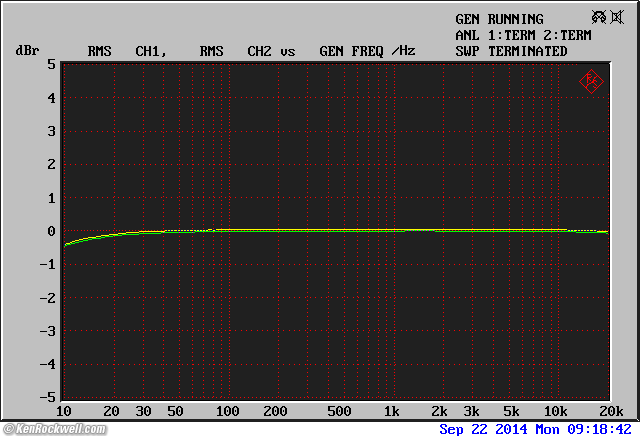
Preamp frequency response.
Perfect! Let's increase the vertical scale:
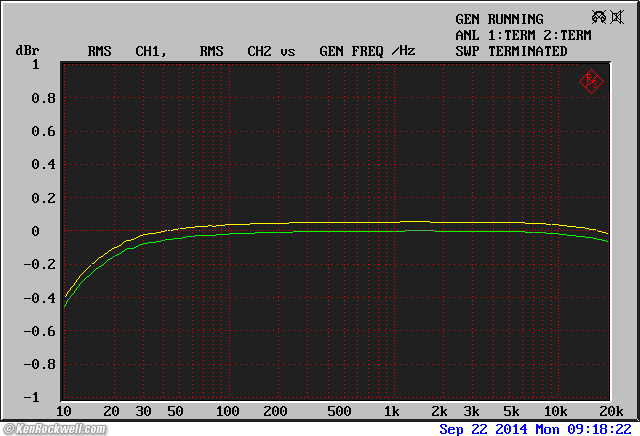
Preamp frequency response.
Good; let's really increase the scale:
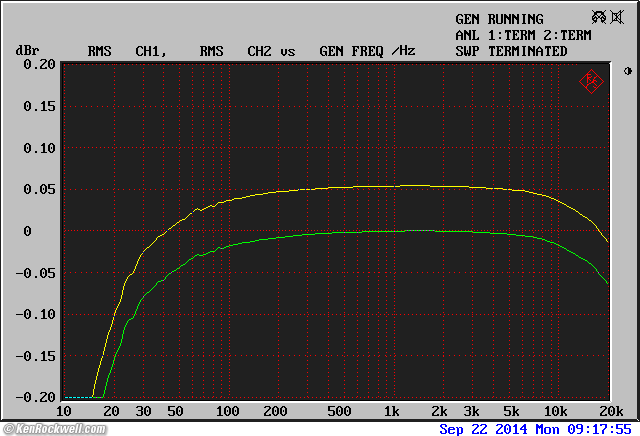
Preamp frequency response.
This is excellent for a consumer preamp.
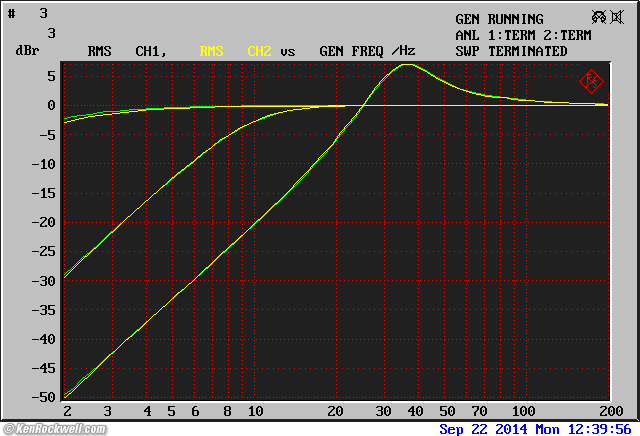
Preamp infrasonic frequency response: filters OFF (flattest line), INFRASONIC FILTER ON (middle line) and BASS EQ (lowest line with peak, same with or without INFRASONIC filter engaged).
It's -3 dB at 1.7 Hz, 9.7 Hz or 22.5 Hz. This is a composite curve; you only get one response at a time.
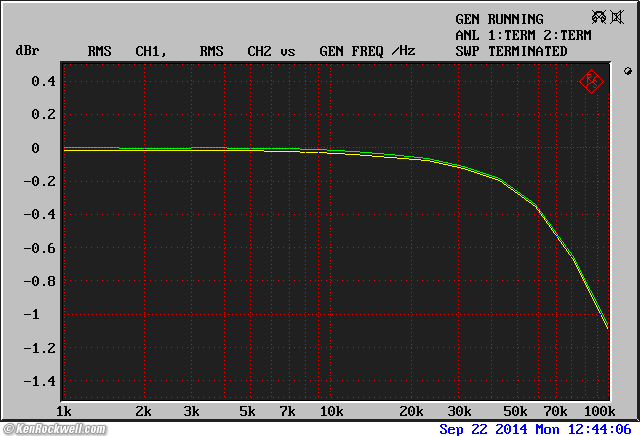
Preamp high-frequency response.
It's -1 dB at 103 kHz, swell.
Preamp Filters Response measurements top
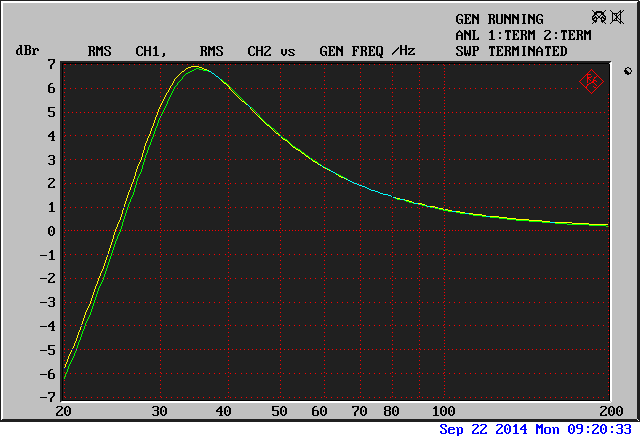
Preamp BASS EQ frequency response.
It's the same as the B&W Bass Alignment Filter set for the B&W Matrix 805.
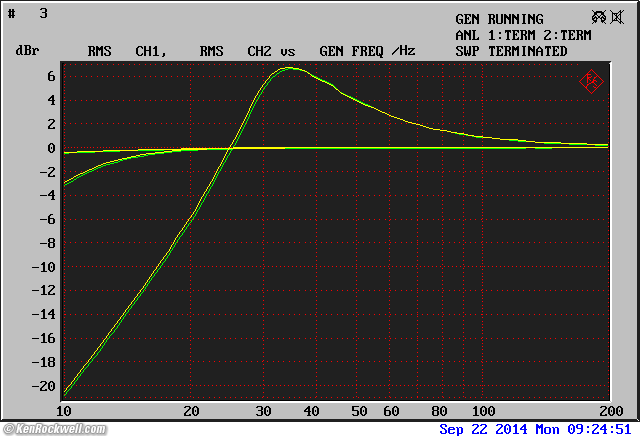
Preamp BASS EQ (peak), flat and infrasonic filter frequency responses.
This is a composite curve; you only get one response at a time.
The infrasonic filter has no additional effect with the BASS EQ active; it's as if either is the same filter with a different Q and Fc setting.
Preamp Tone Controls measurements top
The bass control is a peaking control settable to 50, 120 or 250 Hz, and the treble control is a peaking control settable to 3 kHz, 6kHz or 12 kHz. Each filter is 2 octaves wide at -3 dB.
When left at the clicks, it's flat:
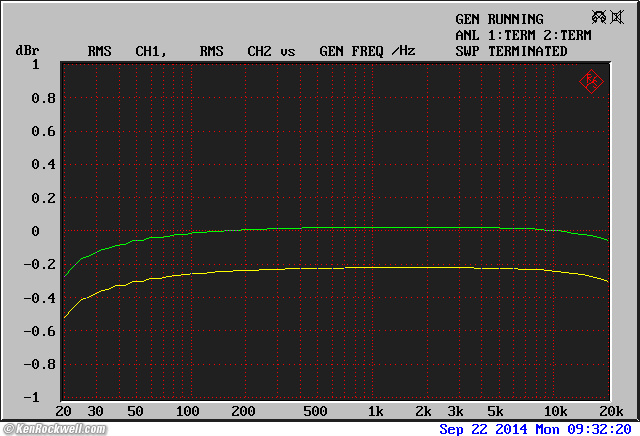
Preamp frequency response, tone active but set flat.
The tone controls add 0.0718 dB extra gain on the left, and lose 0.1678 dB on the right, or a total of 0.24 dB shift towards the left as seen by the two traces here.
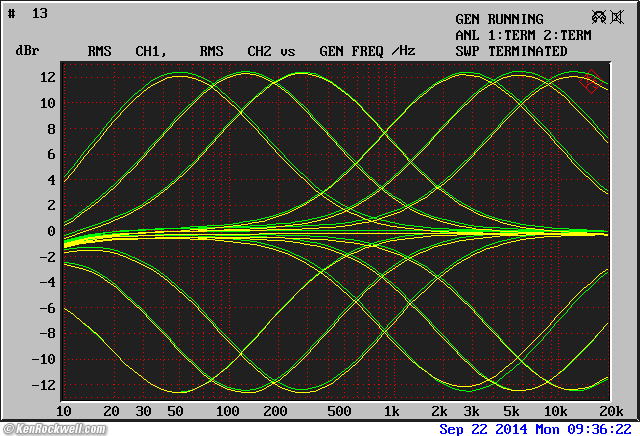
Preamp tone controls frequency response, composite of all extreme settings.
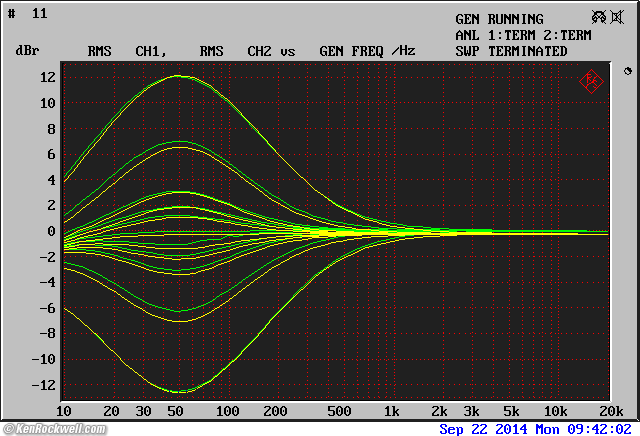
Preamp Bass control set to 50 Hz, composite of responses at each dot on the faceplate.
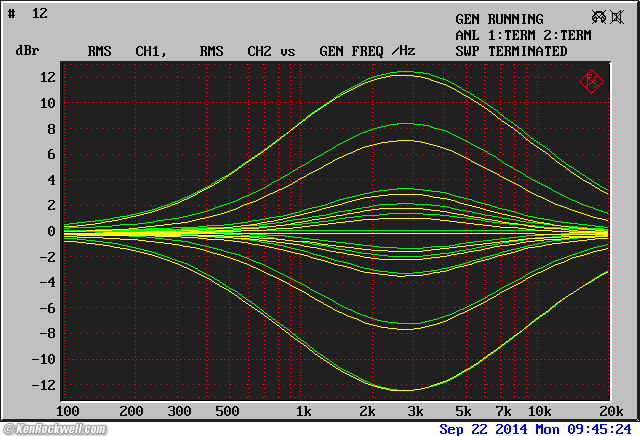
Preamp Treble control set to 3 kHz, composite of responses at each dot on the faceplate.
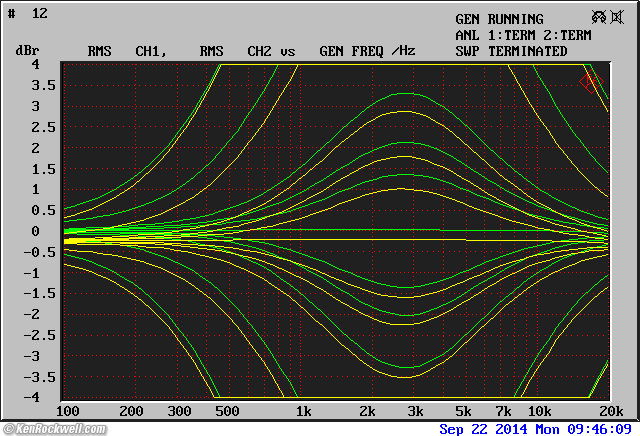
Preamp Treble control set to 3 kHz, composite of responses at each dot on the faceplate, enlarged vertical scale.
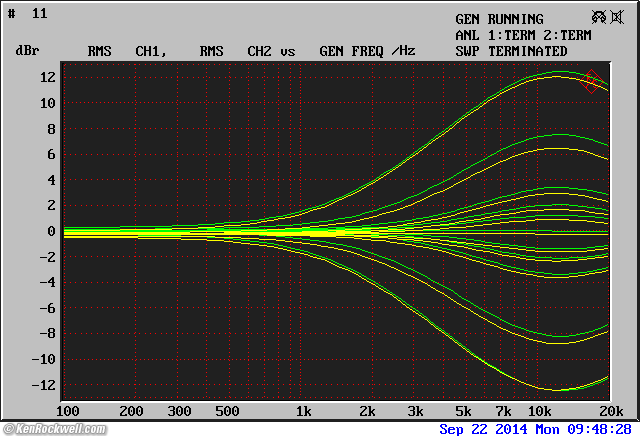
Preamp Treble control set to 3 kHz, composite of responses at each dot on the faceplate.
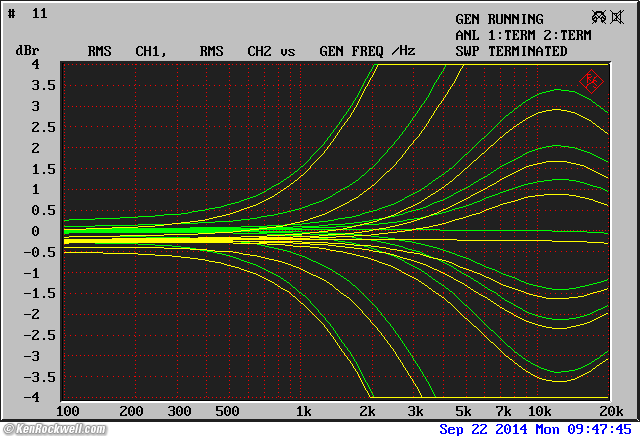
Preamp Treble control set to 3 kHz, composite of responses at each dot on the faceplate, enlarged vertical scale.
Tone Control Responses
Indicated |
50 |
120 |
250 |
3k |
6k |
12k |
|
actual |
50 |
125 |
280 |
2.7k |
5.75k |
12.5k |
|
+5 |
+12.2 |
+12.4 |
+12.4 |
+12.4 |
+12.4 |
+12.1 |
|
+4 |
+7.0 |
+7.1 |
+7.1 |
+7.1 |
|||
+3 |
+3.3 |
+3.1 |
+3.0 |
+3.0 |
|||
+2 |
+2.0 |
+2.0 |
+1.9 |
+1.9 |
|||
+1 |
+1.1 |
+1.2 |
+1.3 |
+1.1 |
|||
0 |
±0.0 |
±0.0 |
±0.0 |
±0.0 |
±0.0 |
±0.0 |
|
-1 |
-1.1 |
-1.4 |
-1.4 |
-1.3 |
|||
-2 |
-1.9 |
-2.1 |
-2.1 |
-2.1 |
|||
-3 |
-2.9 |
-3.3 |
-3.3 |
-3.4 |
|||
-4 |
-6.7 |
-7.8 |
-8.9 |
-8.6 |
|||
-5 |
-12.1 |
-12.4 |
-12.4 |
-12.3 |
-12.3 |
-12.0 |
Preamp THD measurements top
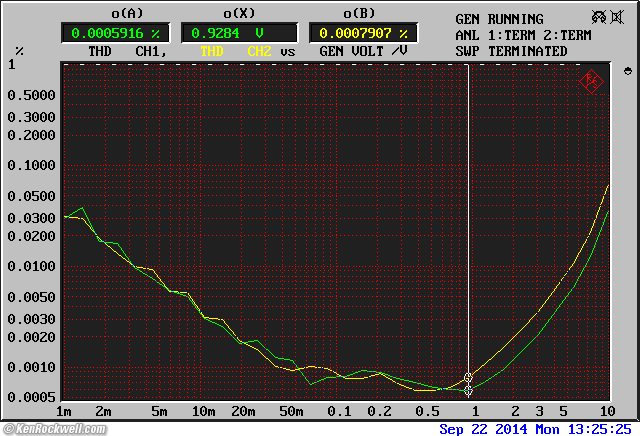
Preamp THD versus level at 1 kHz.
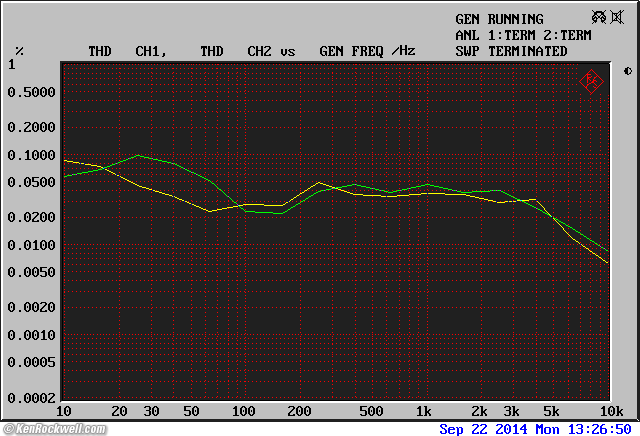
Preamp THD at 1 mV.
This is more noise than THD down at 1 mV.
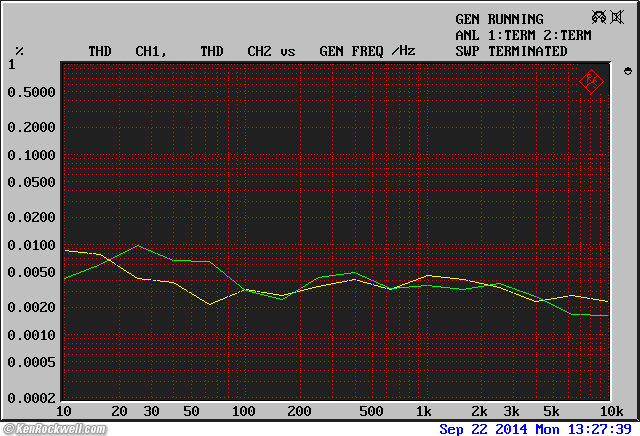
Preamp THD at 10 mV.
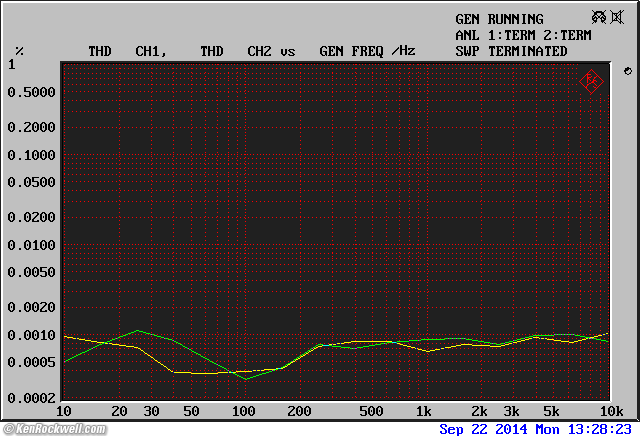
Preamp THD at 100 mV.
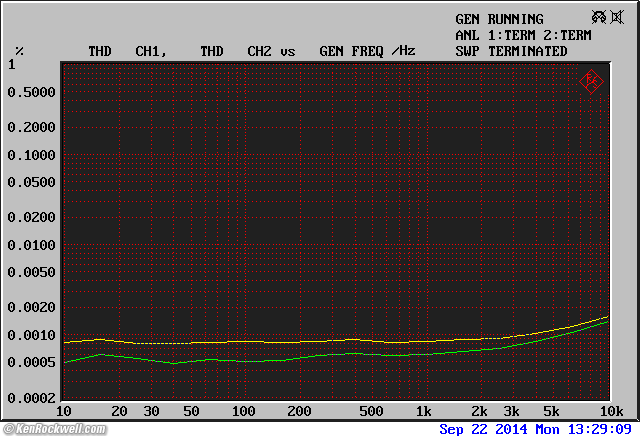
Preamp THD at 1 volt.
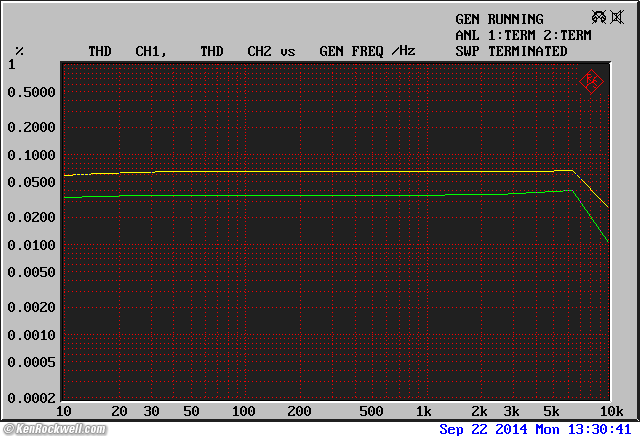
Preamp THD at 10 volts.
Preamp Output Noise measurements top
A Weighted |
Unweighted |
|
MIN |
-118.0 dBV A |
-114.0 dBV |
0 dB gain (12 o'clock) |
-112.7 dBV A |
-109.7 dBV |
MAX |
-102.1 dBV A |
-99.1 dBV |
LOW LEVEL |
A Weighted |
Unweighted |
MIN |
-119.3 dBV A |
-116.3 dBV |
12 o'clock |
-119.3 dBV A |
-116.0 dBV |
MAX |
-118.0 dBV A |
-115.0 dBV |
This is much quieter than average. The 7400 uses the smart variable-feedback gain control.
Phono Preamplifier measurements top
I measured the PHONO preamp at the TAPE 1 output. I drove it from the 5Ω source impedance of the R&S UPL.
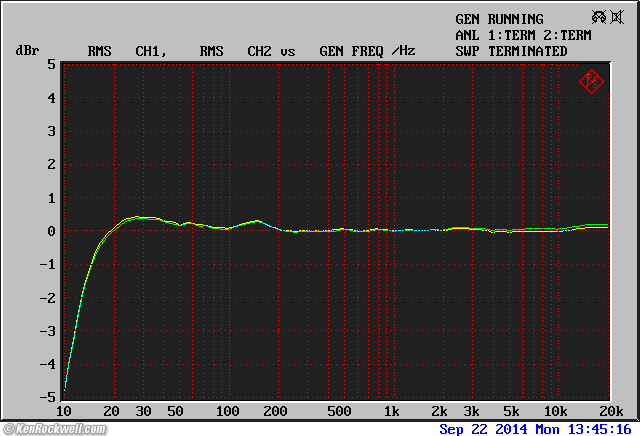
Phono preamp RIAA response. (same for moving magnet and moving coil positions.)
Moving Magnet
Gain at 1 kHz is 35.52 dB left, and 35.54 dB right channel — almost perfect channel balance.
A-weighted noise, with inputs terminated by the the 5Ω source impedance of the R&S UPL, measures -96 dBV.
Maximum input level at 1 kHz is 193 mV which leads to 11.5 V at the tape output at 0.1% THD.
Moving Coil
Gain at 1 kHz is 54.89 dB left, and 54.39 dB right channel.
A-weighted noise, with inputs terminated by the the 5Ω source impedance of the R&S UPL, measures -78 dBV.
Maximum input level at 1 kHz is 20 mV which leads to 11.2 V at the tape output at 0.1% THD.
Power Amp Gain measurements top
29.4 dB left, 29.30 dB right.
Power Amp Channel Balance measurements top
The balance is about 0.10 dB to the left.
Power Amp Input Levels measurements top
8Ω
97 mV for 1 W output.
305 mV for 10 W output.
970 mV for 100 W output.
1.03 V for 115 W output at 0.1% THD, SOFT CLIPPING on.
1.07 V for 120 W output at 1.0% THD, SOFT CLIPPING on.
1.1 V for 129 W continuous output at 0.1% THD.
1.71 V for 315 W 10mS burst power at 1 burst per second at clipping with SOFT CLIPPING on.
1.74 V for 325 W 10mS burst power at 1 burst per second at clipping.
1.85 V for 356 W 1mS burst power at 1 burst per second at clipping.
2.11 V for 367 W 1mS burst power at 1 burst per second at clipping, SOFT CLIPPING on.
4Ω
68 mV for 1 W output.
215 mV for 10 W output.
680 mV for 100 W output.
709 mV for 108 W output at 0.1% THD, SOFT CLIPPING on.
745 mV for 117 W output at 1.0% THD, SOFT CLIPPING on.
765 mV for 125 W continuous output at 0.1% THD.
1.23 V for 328 W 10mS burst power at 1 burst per second at clipping.
1.357 V for 400 W 10mS burst power at 1 burst per second at clipping with SOFT CLIPPING on.
1.43 V for 435 W 1mS burst power at 1 burst per second at clipping.
1.44 V for 435 W 1mS burst power at 1 burst per second at clipping, SOFT CLIPPING on.
Measured Power Consumption measurements top
The 7400 runs comfortably warm. It draws more idle power at the 8Ω setting because the power supply voltages increase.
8Ω setting |
Power Consumption |
Efficiency |
Power off |
1.9 W |
0% |
Idle, CD |
66 W |
0% |
Idle, AM |
70 W |
0% |
Idle, FM |
72 W |
0% |
1 WPC |
91 W |
2.2% |
10 WPC |
168 W |
11.9% |
100 WPC |
419 W |
47.7% |
129 WPC |
470 W |
54.9% |
4Ω setting |
Power Consumption |
Efficiency |
Power off |
1.65 W |
0% |
Idle, CD |
53 W (0.55 A) |
0% |
Idle, AM |
58 W (0.59 A) |
0% |
Idle, FM |
60 W (0.61 A) |
0% |
1 WPC |
75 W (0.79 A) |
2.7% |
Power Output measurements top
8Ω (soft clipping OFF)
Continuous
129 watts per channel, both channels driven, 8Ω position into 8Ω at 0.1% THD.
Burst
325 W 10mS burst power at 1 burst per second at clipping.
356 W 1mS burst power at 1 burst per second at clipping.
8Ω (SOFT CLIPPING ON)
Continuous
115 watts per channel, both channels driven, 8Ω position into 8Ω at 0.1% THD.
125 watts per channel, both channels driven, 8Ω position into 8Ω at 1.0% THD.
Burst
315 W 10mS burst power at 1 burst per second at clipping.
367 W 1mS burst power at 1 burst per second at clipping.
4Ω (soft clipping OFF)
Continuous
125 watts per channel, both channels driven, 8Ω position into 8Ω at 0.1% THD.
Burst
328 W 10mS burst power at 1 burst per second at clipping.
435 W 1mS burst power at 1 burst per second at clipping.
4Ω (SOFT CLIPPING ON)
Continuous
108 watts per channel, both channels driven, 8Ω position into 8Ω at 0.1% THD.
117 watts per channel, both channels driven, 8Ω position into 8Ω at 1.0% THD.
Burst
400 W 10mS burst power at 1 burst per second at clipping.
435 W 1mS burst power at 1 burst per second at clipping.
Power Amp Damping Factors measurements top
Output source impedance |
Damping Factor, 8Ω |
|
50 cyc |
28.8 mΩ |
278 |
1 kc |
26.2 mΩ |
305 |
20 kc |
61.0 mΩ |
131 |
Power Amp Output Noise measurements top
A Weighted |
Unweighted |
-88 dBV A |
-84 dBV |
Power Amp Signal to Noise Ratio (SNR) measurements top
97 dB A-weighted SNR (15.8 effective bits) referred to 1 watt into 8Ω (2.83 V or +9.031 dBV).
117 dB A-weighted SNR (19.1 effective bits) referred to 100 watts into 8Ω (28.3 V or +29.031 dBV).
Power Amplifier Output DC Offset measurements top
-12 mV left, -2.6 mV right.
Power Amp Frequency Response measurements top
NAD 7400 power amplifier frequency response.
NAD 7400 power amplifier frequency response, expanded scale.
This is swell. The biggest problem is the 0.1 dB channel imbalance.
NAD 7400 power amplifier infrasonic frequency response.
-3 dB at 3.5 Hz; swell.
NAD 7400 power amplifier ultrasonic frequency response.
-3 dB at 100 kHz, swell.
Power Amp THD: 0.003% (-90 dB) measurements top
All these THD measurements are measuring pure distortion components only (THD only), not noise and distortion (THD+N). THD+N numbers would be worse than THD alone shown here.
Harmonic Distortion at 10 mW
NAD 7400 THD at 10 mW.
Harmonic Distortion at 1 watt
NAD 7400 THD at 1 watt.
Swell, nothing to hear here.
Harmonic Distortion at 10 watts
NAD 7400 THD at 10 W.
Harmonic Distortion at 100 watts
NAD 7400 THD at 100 W.
Even at close to clipping, nothing to hear here.
Harmonic Distortion Components at 10 mW
NAD 7400 harmonic distortion components at 10 mW..
Harmonic Distortion Components at 1 watt
7400 harmonic distortion components at 1 W.
Perfect, mostly second and third harmonics.
Harmonic Distortion Components at 100 watts
7400 harmonic distortion components at 100 W.
Even better; mostly second harmonic.
19+20 kHz Difference-Frequency Distortion (DFD)
per DIN IEC 268-3 or 118:
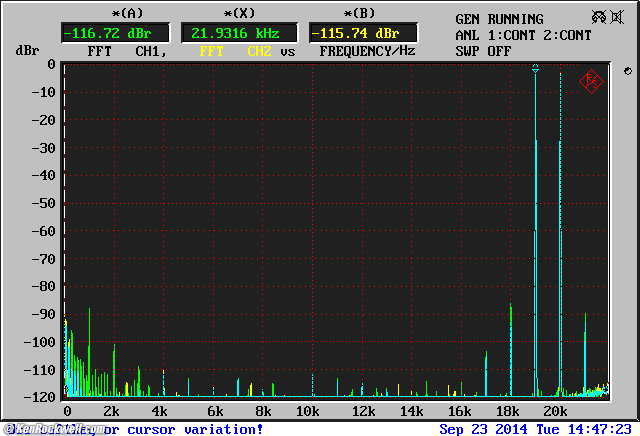
DFD at 1 W RMS total output.
The 1 kHz component is at -89 dB, which is superb reasonable at 1 watt.
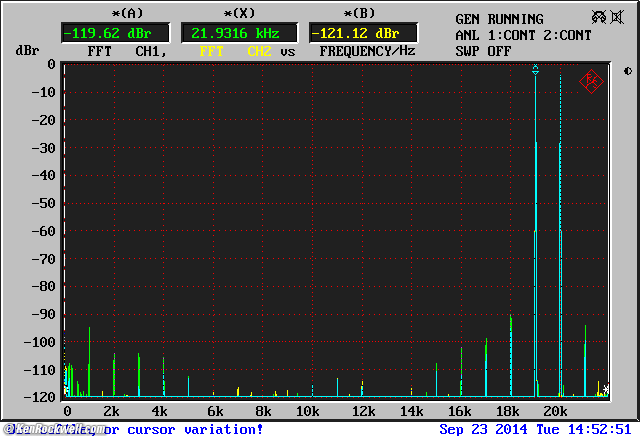
DFD at 50 W RMS total output.
The 1 kHz component is lower, at -94 dB, which is excellent.
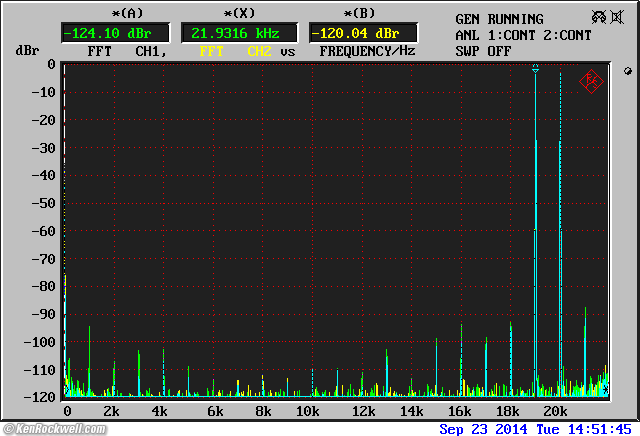
DFD at 100 W RMS total output.
The 1 kHz component is at -94 dB, which is superb at 100 watts.
In fact, this is the Power Envelope at work; it would only do this for a few seconds and then the distortion increased greatly because the peak outputs for this difficult test signal at 100 W RMS are considerably greater than 100W. The NAD 7400 has so much reserve power that I could actually get a measurement and press the PRINT button before the high-voltage peak supply petered out.
The close-in 18 kHz and 21 kHz skirts are around -90 dB, which are also magnificent at this high power level. At this level, your tweeters will blow in an instant so it's not that critical.
Power Amp Performance into 4Ω measurements top
Power output is already measured above.
Here are frequency response and THD at 4Ω, at the 4Ω setting:
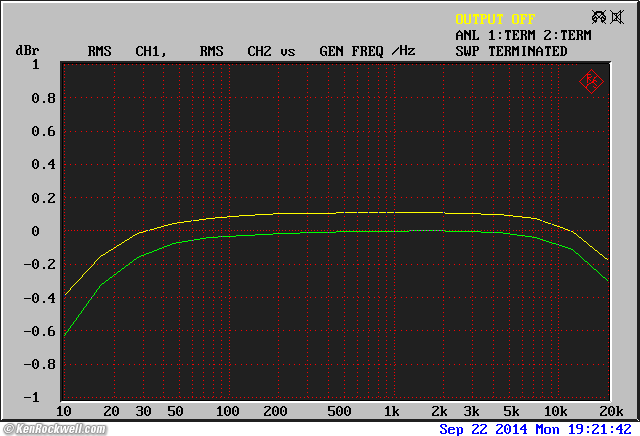
Frequency response into 4Ω.
Excellent, it's almost as flat as at 8Ω.
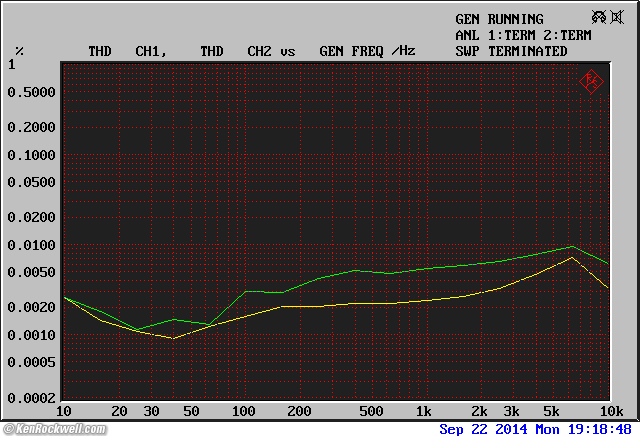
THD at 1 watt into 4Ω.
Excellent, it's almost unchanged from 8Ω.
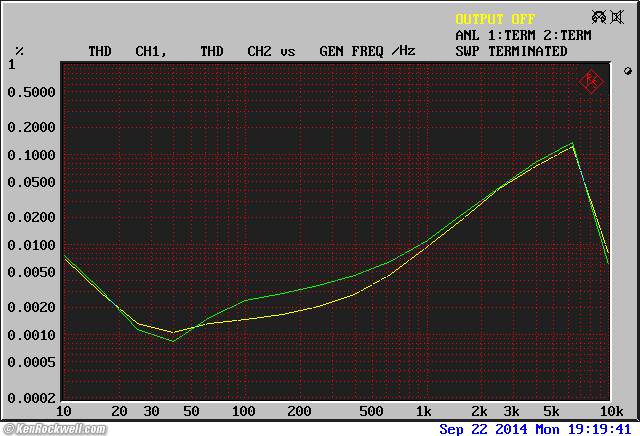
THD at 100 watts into 4Ω.
It's higher at the high frequencies than at 8Ω, but I'm using cheap wire-wound inductive 4Ω resistors compared to my nice precision 8Ω loads, so I have no idea if the phase angles were doing something here. It doesn't matter, as no tweeter can handle 100 W continuous anyway and these measurements are still far below audibility.
System Gain measurements top
45.6 dB from CD in to speakers out.
LOW LEVEL: 24.3 dB from CD in to speakers out.
14.8 mV at the CD input produces 1 W output at the speakers at maximum gain.
172 mV at the CD input produces 1 W output at the speakers at maximum gain at LOW LEVEL.
Compared top
Intro Specifications Measurements Compared
The 7400 is a larger version of the more popular 7100, rated 100W instead of 50 W or 60W per channel of the 7100 or 7100X.
Compared to the common 7100, this 7400 adds a real spinning flywheel digital tuning knob, a metal instead of a plastic faceplate, a front panel PROTECTION indicator LED, the ability to defeat the weak-FM-signal semi-muting, and brilliant semi-parametric tone controls.
The 7400 replaces the relatively useless Loudness button of the 7100 with a Tone Defeat button. The tone controls are so good in the 7400 that the defeat switch isn't needed, either.
This 7400 has extremely useful tone controls, while the 7100's tone controls are relatively useless.
Usage top
Intro Specifications Measurements Compared
Remote and Power
The receiver's power light is dim green in standby. It blinks as it receives remote commands.
LOW LEVEL is selected by default at power on. It lowers preamp output noise, too. If you want to play loud, you have to press the LOW LEVEL button to make it go away.
Often one has to hit the TUNER AMP button on the remote before it will make input selections. If you hit CD or TAPE, it alters the remote to talk to a NAD CD or Tape player and shared-purpose buttons won't talk to the receiver until you press TUNER AMP again. If it's not working, just press TUNER AMP and it will again.
Infrasonic filter and BASS EQ
The INFRA switch on the rear works for all inputs.
Oddly it doesn't have any effect with bass EQ.
Tuner
The FM tuner quiets the audio by about 15 dB on weak stations instead of just muting them. The FM NR OFF button lets them all play at full level.
There is no SCAN function; just spin the dial like a real radio. The remote does have a SCAN button.
To get the remote to talk to the tuner, you have to play Simon Says and press the TUNER remote button, and then the tuner buttons on the remote. For instance, unlike a B&O you can't just press a radio preset on the remote; you have to press POWER, TUNER (select a band) and then the preset.
7 memory buttons x 2 banks. The tally LED above each changes color with bank.
To save the tuned station, select desired memory bank > press enter button > select desired memory address.
Each memory location may be either AM or FM.
If you hit Enter by accident, wait 10 seconds or tune away or change band or input. It should cancel with a second push of the Enter button, but it doesn't.
It has a two week radio memory. It may forget the presets after a month.
When you press the AM or FM band selectors, it recalls the station last used in that band, as well as remembering if it was from memory . Therefore if you're clever, the FM and AM buttons will switch the Memory Banks for you if you use one bank for AM and the other for FM. If you're tuned to a non-memory station, it won't change the banks for you while changing bands.
Mono
The same button forces the FM tuner to mono, as well as anything going through the preamp.
Depending on how you have your selectors set, it may or may not force the Tape Output to mono.
Headphones
The headphone jack is always live, regardless of speaker selections. The output is simply the speaker outputs fed via a 470 Ω series resistor, and the power amp is so quiet that it's silent.
Recommendations top
Intro Specifications Measurements Compared
The NAD 7400 is a great receiver.
Its best virtues are styling as good as ADS or B&O, great, simple controls, a great remote, and a very closely tracking volume control. This is a product that actually works much better than brands designed in the Orient with controls and remotes with so many buttons that no one can ever get the music to play. With this NAD, it looks great, and it's easy to get the music on and tune the radio. It was designed in Belgium.
Since it separates into discrete power amplifier and preamplifier, you can integrate it into any sort of complex system. Technically, it sounds and tests very well.
For about $250 used today (see How to Win at eBay), most samples are pretty worn out. Most samples I've seen get damaged in shipping, or have front-panel buttons that don't always work (sometimes you have to wait a moment and try again; the remote control always works even if the front panel doesn't), and others simply wouldn't pull-in the speaker relays and play music. If you get a good one, great, but sadly it will be difficult to get a good used one today.
More Information top
Intro Specifications Measurements Compared
pre/main jumpers 3.2mm diameter, 21.4 OD/15.0 ID (18.2 spacing), 25mm long
See also Leonard Feldman's review in Audio Magazine, August 1989. Click any of the pages with graphs to enlarge them:
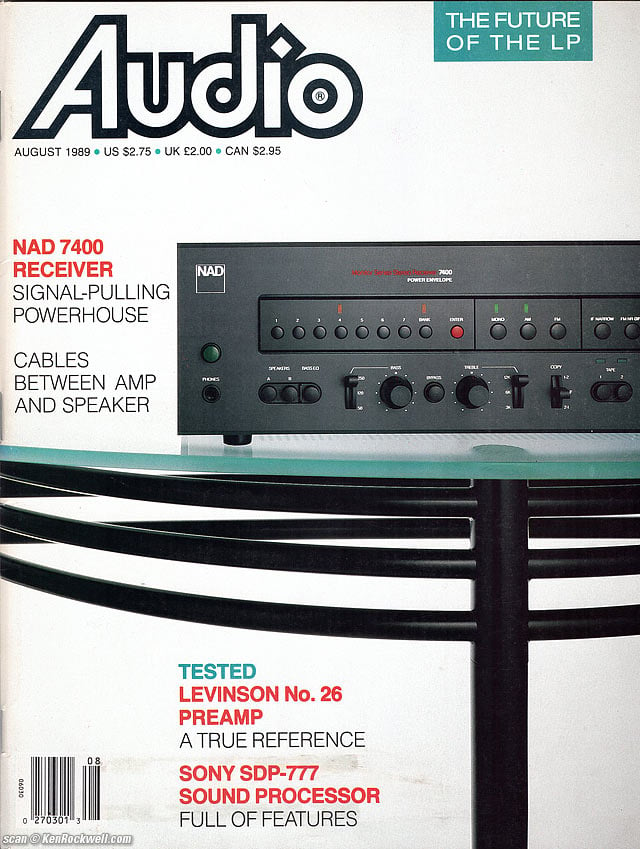
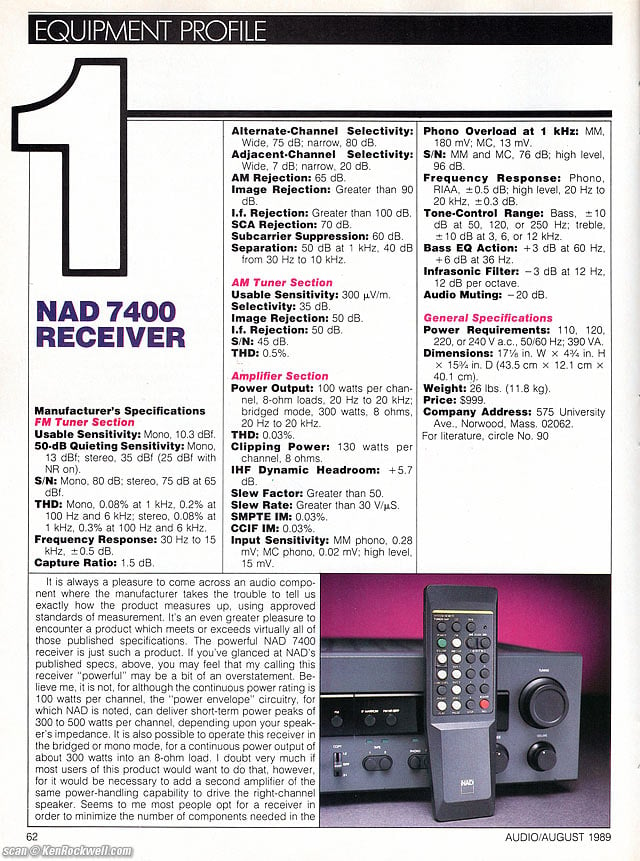
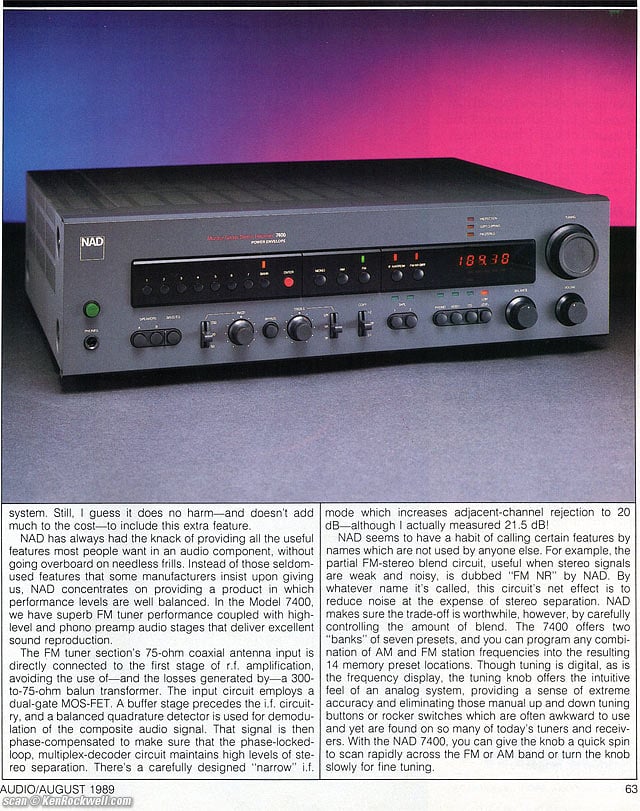
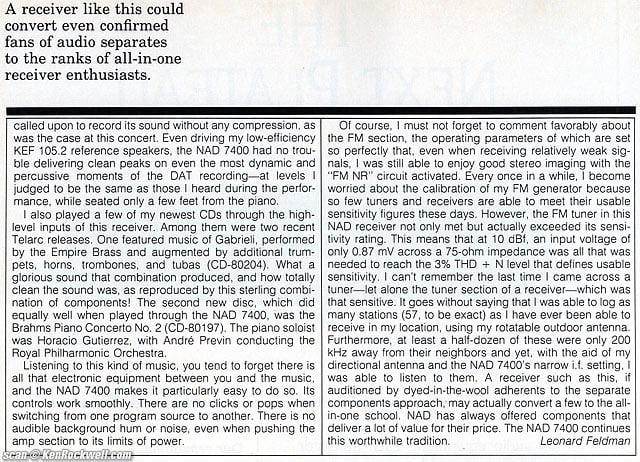
Help me help you top
I support my growing family through this website, as crazy as it might seem.
The biggest help is when you use any of these links when you get anything, regardless of the country in which you live. It costs you nothing, and is this site's, and thus my family's, biggest source of support. These places have the best prices and service, which is why I've used them since before this website existed. I recommend them all personally.
If you find this page as helpful as a book you might have had to buy or a workshop you may have had to take, feel free to help me continue helping everyone.
If you've gotten your gear through one of my links or helped otherwise, you're family. It's great people like you who allow me to keep adding to this site full-time. Thanks!
If you haven't helped yet, please do, and consider helping me with a gift of $5.00.
As this page is copyrighted and formally registered, it is unlawful to make copies, especially in the form of printouts for personal use. If you wish to make a printout for personal use, you are granted one-time permission only if you PayPal me $5.00 per printout or part thereof. Thank you!
Thanks for reading!
Mr. & Mrs. Ken Rockwell, Ryan and Katie.
Home Donate New Search Gallery Reviews How-To Books Links Workshops About Contact
